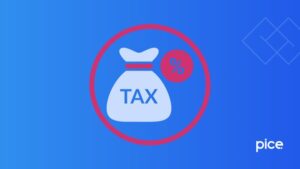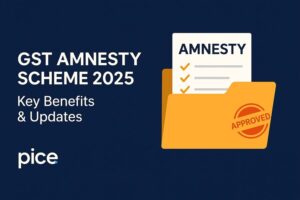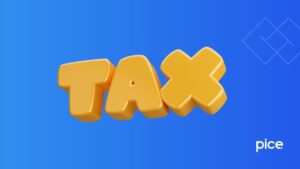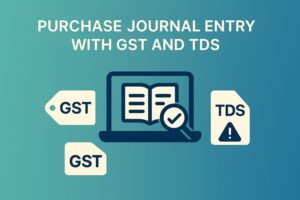A Guide on How to Avail Composition Scheme under GST
- 13 Aug 24
- 18 mins

A Guide on How to Avail Composition Scheme under GST
- What are the GST Composition Scheme Rules?
- Benefits of the Composition Scheme Under GST
- Eligibility: Who Can opt for the Composition Scheme Under GST?
- Step-by-Step Guide: How to opt for Composition Scheme Under GST
- Trade-offs: What You Lose in Composition Scheme Under GST
- Tax Rates Applicable for the Composition Scheme in GST
- Application Process: How to Apply for the GST Composition Scheme
- Conclusion
Key Takeaways
- Simplified Tax Compliance: The GST Composition Scheme significantly simplifies the tax compliance process for small and medium-sized enterprises (SMEs) by offering easier filing procedures, reduced compliance requirements, and minimal record-keeping.
- Reduced Tax Rates: Businesses under the Composition Scheme benefit from lower GST rates, ranging from 1% to 6%, depending on their business type. This can lead to substantial tax savings, especially for those with slim profit margins.
- Restrictions on Business Operations: While the scheme simplifies tax processes, it imposes restrictions such as no interstate sales, no sales through e-commerce platforms, and the inability to claim input tax credit (ITC), which could influence business strategies and operations.
- Eligibility Criteria: The scheme is accessible to industries with an annual turnover of up to INR 1.5 crores (INR 75 lakhs for special category states) and includes manufacturers, traders, restaurant services, and certain service providers, with specific exclusions in place.
The GST (Goods and Services Tax) composition scheme is a tax regime in India designed to simplify compliance for small and medium enterprises. This scheme allows eligible industries to pay GST at a fixed rate of their turnover instead of paying tax on every transaction. The primary aim of the composite scheme is to reduce the compliance burden on small taxpayers and make it easier for them to manage their tax obligations.
What are the GST Composition Scheme Rules?

The composition scheme under GST comes with its own set of rules and conditions. Eligibility criteria, turnover limits, and the nature of transactions are key aspects governing who can opt for this scheme. Having knowledge of these rules is important for industries considering this option.
Eligibility Criteria
- Turnover Threshold: The scheme is available to businesses with an annual turnover of up to INR 1.5 crore. For special category states, the threshold is INR 75 lakh. These thresholds are subject to periodic updates.
- Type of Business: Manufacturers, traders, and restaurant service providers can opt for the scheme. Specific service providers are also eligible under certain conditions.
- Geographical Limitation: Businesses must not engage in interstate supplies or make supplies through e-commerce platforms that require e-way bill generation.
Tax Rates under the Scheme
- Manufacturers and Traders: A nominal GST rate of 1% (0.5% CGST + 0.5% SGST) on the turnover.
- Restaurants not Serving Alcohol: A 5% GST rate applies.
- Other Eligible Service Providers: A GST rate of 6% (3% CGST + 3% SGST) on the turnover.
Restrictions and Conditions
- No Input Tax Credit: Businesses opting for the scheme cannot claim input tax credit on their purchases.
- Interstate Sales: Interstate sales are prohibited for businesses under this scheme. All supplies must be within the state.
- Bill of Supply: Instead of a regular tax invoice, a composition dealer must issue a bill of supply, as they cannot collect GST from their customers.
- Tax Payment and Filings: Taxpayers under this scheme are required to pay tax on a quarterly basis and file a quarterly return in Form GSTR-4, in addition to an annual return in Form GSTR-9A.
Opting In and Out of the Scheme
- Opt-In Process: Eligible businesses need to file an intimation for opting into the composition scheme at the beginning of the financial year for which the option is exercised.
- Opt-Out: A taxpayer can opt out of the scheme voluntarily. However, if the taxpayer breaches the scheme's conditions (e.g., exceeds the turnover threshold or makes interstate supplies), they will be automatically moved out of the scheme and switched to the regular GST regime.
Compliance and Record-Keeping
- Simplified Records: The scheme allows for simplified record-keeping, but businesses must still maintain records of purchases, supplies, and taxes due.
- No E-commerce Sales: Businesses under this scheme are not allowed to sell goods through e-commerce platforms.
Benefits of the Composition Scheme Under GST
The Composition Scheme under the Goods and Services Tax (GST) framework offers several benefits to small and medium-sized enterprises (SMEs) in India, making it a popular option for businesses seeking to simplify their tax obligations. Here are the key benefits of the GST Composition Scheme:
Simplified Compliance
- Reduced Compliance Burden: Businesses under this Scheme have to comply with fewer GST filings compared to regular taxpayers. They are required to file quarterly returns instead of monthly returns, significantly reducing the compliance workload and complexity.
- Simplified Record-Keeping: The need for detailed record-keeping is minimized, as composition dealers are not allowed to claim input tax credit (ITC) and therefore do not need to maintain extensive purchase records for tax purposes.
Lower Tax Liability
- Lower Tax Rates: One of the most significant benefits is the lower GST rates applicable to composition dealers. These rates are substantially lower than the standard GST rates, ranging from 1% to 6%, depending on the type of business (manufacturers, traders, restaurants, and service providers). This can lead to considerable tax savings, especially for businesses with a small profit margin.
Increased Liquidity
- No Input Tax Credit: While being unable to claim ITC might seem like a drawback, it simplifies the tax process for businesses and results in better cash flow management since tax is paid at a nominal rate on the overall turnover.
Ease of Doing Business
- Ease of Tax Payment and Filing: The process of calculating tax liability is straightforward under this scheme, as it is based on turnover rather than the value of taxable supply. This simplicity facilitates easier tax payment and filing processes.
- Lesser Financial Strain: With reduced tax rates and compliance requirements, small businesses can operate with less financial strain, allowing them to focus on their business growth and operations.
Reduces Litigation Risk
Minimized Tax Disputes: The straightforward nature of this scheme, with its fixed tax rate on turnover, reduces the chances of disputes over tax liabilities and compliance issues with the GST authorities.
Business Focus
- Focus on Business Rather Than Compliance: By easing the compliance and tax burden, this Scheme allows business owners to focus more on their core business activities, market expansion, and customer engagement rather than being preoccupied with tax compliance and filings.
Suitable for Small Businesses
- Tailored for Small Businesses: The scheme is specifically designed for small businesses that might find the regular GST regime too cumbersome or complex. It supports their sustainability and growth by offering a simpler and more manageable tax framework.
Eligibility: Who Can opt for the Composition Scheme Under GST?
Not all businesses are eligible for the GST composition scheme. This part of the article will cover the criteria that businesses must meet to opt for this scheme, such as turnover limits and the type of goods or services provided.

Turnover Threshold
- General Limit: Businesses with an annual turnover of up to INR 1.5 crores can opt for the Composition Scheme. This threshold applies to most businesses across India.
- Special Category States: For businesses operating in the Northeastern states, Himachal Pradesh, and Uttarakhand, the turnover limit is INR 75 lakhs.
Business Type
- Manufacturers and Traders: Both manufacturers and traders of goods are eligible to opt for the Composition Scheme, provided they meet the turnover criteria.
- Restaurants and Food Services: Restaurants and food service businesses that do not serve alcohol can opt for this scheme.
- Service Providers: Initially, service providers were largely excluded from the scheme. However, recent amendments now allow certain service providers (with a turnover of up to INR 50 lakhs) to opt for the Composition Scheme.
Specific Exclusions
Certain types of businesses and transactions are explicitly excluded from opting for the Composition Scheme, including:
- Interstate Suppliers: Businesses that supply goods or services across state borders cannot opt for the Composition Scheme.
- E-commerce Operators: Businesses that sell goods or services through e-commerce platforms are not eligible.
- Non-taxable Goods Suppliers: Suppliers of non-taxable goods, such as alcohol for human consumption and petroleum products, cannot opt for the scheme.
- Manufacturers of Notified Goods: A few goods that the GST council has notified are also not included in the program.
Voluntary Participation
Eligible businesses must voluntarily opt-in to the Composition Scheme by filing the necessary forms at the beginning of the financial year or upon becoming eligible. It's important to note that once opted in, businesses must comply with all the rules and conditions of the scheme.
Other Conditions
- Legal Compliance: Businesses opting for the Composition Scheme must not have any pending GST dues or legal issues that could affect their eligibility.
- One Scheme for All Business Verticals: If a business owner has multiple business verticals under the same PAN, all must collectively opt for or opt out of the Composition Scheme.
Restrictions: Who cannot opt for the composition scheme under GST?
Certain businesses and transactions are excluded from the composition scheme. Understanding these restrictions is essential for businesses to make an informed decision about whether the scheme is right for them.
- Interstate Sales: Businesses that engage in interstate sales, meaning selling goods or services outside their own state, cannot opt for the Composition Scheme.
- E-commerce Sellers: Businesses that sell goods or services through e-commerce platforms are not eligible for the scheme.
- Service Providers (with exceptions): Initially, most service providers were excluded, but recent updates allow certain service providers with a turnover of up to INR 50 lakhs to opt in. However, many service providers still remain ineligible.
- Non-taxable and Exempt Goods Suppliers: Suppliers of non-taxable goods, such as alcohol for human consumption, and suppliers of exempt goods are not eligible for the Composition Scheme.
- Manufacturers of Certain Goods: Manufacturers of certain goods notified by the GST Council, such as ice cream, pan masala, and tobacco, cannot opt for the Composition Scheme.
Step-by-Step Guide: How to opt for Composition Scheme Under GST

Opting for the composition scheme requires businesses to follow a specific process, including registration and meeting compliance requirements. This section will provide a detailed guide on how to opt into the scheme.
Step 1: Assess Eligibility
Before proceeding, ensure your business meets the eligibility criteria for the Composition Scheme, including the turnover threshold and the nature of your business. Businesses engaged in interstate supplies, e-commerce sales, or supplying non-eligible goods and services cannot opt for the scheme.
Step 2: Login to the GST Portal
Access the official GST portal (gst.gov.in). You will need your GSTIN (Goods and Services Tax Identification Number) and password to log in to your account.
Step 3: Navigate to the Opt-In Form
Once logged in, navigate to the dashboard and find the option for the Composition Levy under the Services menu. Select the ‘Application to opt for Composition Levy’ form (GST CMP-02) for the financial year you wish to opt in.
Step 4: Fill Out the Application
Carefully fill out the application form, providing all required information accurately. This includes the financial year for which you are opting into the scheme and details about your business.
Step 5: Submit the Application
After reviewing your application and ensuring all details are correct, submit the form online through the GST portal. Keep a record of the acknowledgment for future reference.
Step 6: Issue a Notice of Stock Intimation
Businesses opting into the Composition Scheme must file a statement in form GST CMP-03 within 60 days of the commencement date, detailing the stock, including the inputs and capital goods, held by them on the day they opted for the Composition Scheme.
This is important for businesses transitioning from the regular scheme as it pertains to eligibility for input tax credit on the stock.
Step 7: File Form GST ITC-03 (if applicable)
If you were previously registered under the regular GST scheme, you must file form GST ITC-03 within 60 days of opting into the Composition Scheme. This form declares details of inputs held in stock, inputs contained in semi-finished or finished goods held in stock, and capital goods for which input tax credit needs to be reversed since the Composition Scheme does not allow input tax credit.
Step 8: Compliance Post-Opt-In
After successfully opting into the Composition Scheme, ensure compliance with its rules. This includes not making interstate sales, issuing a bill of supply instead of a tax invoice for sales, and paying the fixed percentage of your turnover as GST. Remember, you are also required to file GST returns quarterly using form GSTR-4.
Step 9: Display Composition Taxpayer Status
Finally, you must display “Composition taxable person, not eligible to collect tax on supplies” at your place of business and on every notice or signboard. This informs your customers that you are under the Composition Scheme and not charging GST on supplies.
Trade-offs: What You Lose in Composition Scheme Under GST
While the composition scheme offers benefits, there are also trade-offs, such as limited input tax credit and restrictions on interstate sales. This segment will explore what businesses may lose by choosing this scheme.
- No Interstate Sales: Businesses cannot engage in interstate sales or exports. This limitation could restrict business growth opportunities, especially for those looking to expand their market reach beyond their state.
- No Input Tax Credit (ITC): One of the major trade-offs is the inability to claim Input Tax Credit on purchases. This could result in a higher cost of inputs, affecting overall profitability.
- Limited to Specific Businesses: Not all businesses can opt for the scheme. Service providers (with some exceptions) and businesses involved in supplying non-eligible goods or services are excluded.
- Tax on Reverse Charge Mechanism (RCM): Businesses under the Composition Scheme are still liable to pay tax on reverse charge basis for applicable purchases, without the benefit of claiming ITC.
- Restrictions on Customers: Since composition dealers cannot issue tax invoices, their customers, who are GST-registered, cannot claim ITC on their purchases, potentially making the business less attractive to such customers.
- No E-commerce Sales: Businesses cannot sell goods or services through e-commerce platforms, limiting access to one of the fastest-growing market channels.
- Compliance on Withdrawal: If a business decides to withdraw from the Composition Scheme or becomes ineligible, transitioning back to the regular GST scheme involves compliance challenges, including the requirement to start issuing tax invoices and the ability to claim ITC.
Tax Rates Applicable for the Composition Scheme in GST
The GST composition scheme offers different tax rates compared to the regular GST regime. This part will outline the tax rates applicable to businesses under the composition scheme, based on their type of operation.
- Manufacturers and Traders of Goods: Typically pay a GST rate of 1% of their turnover.
- Restaurants not Serving Alcohol: are charged at a rate of 5% of their turnover.
- Service Providers and Mixed Suppliers: Eligible service providers and those supplying both goods and services can opt for the scheme, paying a GST rate of 6% on their turnover.
Simplified Filing: How Easy Is It to File Composite GST Returns?
One of the key benefits of the GST composition scheme is the simplified filing process. This section will explain how the scheme makes GST returns filing easier for businesses.
Quarterly Returns
Frequency: Composition Scheme taxpayers are required to file GST returns only once every quarter, as opposed to monthly filings required under the regular GST regime. This reduces the administrative burden on small businesses significantly.
Form GSTR-4
Simplified Form: Taxpayers under the Composition Scheme need to file Form GSTR-4 by the 18th of the month following the end of the quarter. This form is considerably simpler than the forms required for regular GST filings, requiring less detailed information. Annual Return: In addition to quarterly returns, composition dealers are also required to file an annual return using Form GSTR-9A.
No-Input Tax Credit (ITC) Reconciliation
Reduced Complexity: Since taxpayers under the Composition Scheme cannot claim Input Tax Credit (ITC), they are not required to maintain detailed purchase records or perform ITC reconciliation, which is a complex and time-consuming process for regular taxpayers.
Online Filing
GST Portal: The entire process of filing returns under the Composition Scheme can be completed online via the GST portal, making it accessible and straightforward. The GST portal provides instructions and assistance to ensure accurate and timely filings.
Automated Calculations
Turnover-Based Tax: Since the tax liability under the Composition Scheme is based on turnover, the GST portal often automates calculations, further simplifying the filing process.
Key Points for Simplified Filing
- Less Frequent Filings: Quarterly instead of monthly returns.
- Simplified Form: Use of Form GSTR-4 for quarterly filings and Form GSTR-9A for the annual return.
- No Detailed Invoices: There is no need to upload individual sales invoices.
- Online Process: Easy and accessible online filing through the GST portal.
Application Process: How to Apply for the GST Composition Scheme

Applying for the GST composition scheme is a straightforward process, but it requires careful attention to detail. This guide will walk businesses through the application process step-by-step.
Step 1: Check Eligibility
Ensure your business meets the eligibility criteria for the GST Composition Scheme. This includes turnover limits and the nature of your business activities. Ineligible businesses, such as those engaged in interstate supplies or e-commerce sales, cannot opt for the scheme.
Step 2: Login to the GST Portal
Access the GST portal (gst.gov.in) using your credentials. You'll need your GSTIN (Goods and Services Tax Identification Number) and password to log in.
Step 3: Navigate to the Application Form
Once logged in, go to the 'Services' menu, select 'Registration', and then click on 'Application to Opt for Composition Levy'. This will direct you to form GST CMP-02.
Step 4: Fill and Submit Form GST CMP-02
Complete the application form by selecting the financial year for which you wish to opt into the Composition Scheme and providing any other required details. After reviewing your application for accuracy, submit the form online through the GST portal.
Step 5: File Form GST CMP-03 (if applicable)
If you have existing stock that was purchased from inter-state suppliers, you must declare it using form GST CMP-03 within 90 days of opting into the Composition Scheme. This form details the stock, including inputs and semi-finished goods, on which input tax credit (ITC) is to be availed.
Step 6: Comply With Scheme Requirements
After opting in, ensure you comply with all the scheme’s requirements, such as issuing bills of supply instead of tax invoices, not collecting GST from customers, and paying tax at the prescribed rates based on your turnover.
Step 7: File Quarterly Returns
Under the Composition Scheme, you're required to file quarterly returns using form GSTR-4, unlike regular taxpayers who file monthly returns. Ensure timely submission to avoid penalties.
Additional Points to Consider
- Voluntary Opt-In: Remember, opting for the GST Composition Scheme is voluntary. You can opt in at the beginning of the financial year or upon becoming eligible.
- Display Composition Taxpayer Status: You must display a board at your place of business and on every notice or signboard, indicating that you are a composition taxpayer.
Conclusion
The GST composition scheme is an excellent initiative for small and medium-sized businesses in India, offering a simplified tax regime that can help reduce the compliance burden. However, it's important for businesses to carefully consider the eligibility criteria, benefits, and trade-offs before opting in.
💡Download the Pice GST Payment App now and simplify tax compliance, reduce the tax burden, and focus more on their operations and growth.
 By
By 















